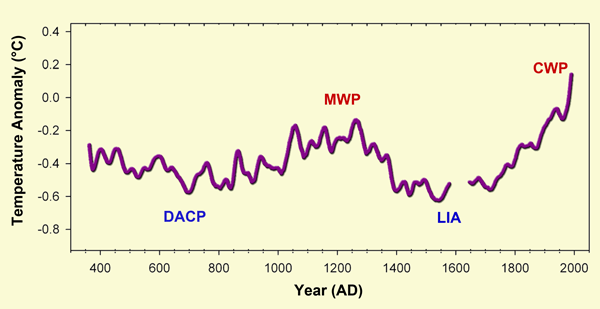Reference
Kellerhals, T., Brutsch, S., Sigl, M., Knusel, S., Gaggeler, H.W. and Schwikowski, M. 2010. Ammonium concentration in ice cores: A new proxy for regional temperature reconstruction? Journal of Geophysical Research 115: 10.1029/2009JD012603.
Background
The authors write that "to place recent global warming into a longer-term perspective and to understand the mechanisms and causes of climate change, proxy-derived temperature estimates are needed for time periods prior to instrumental records and regions outside instrumental coverage." And in this regard they note that "for tropical regions and the Southern Hemisphere ... proxy information is very fragmentary."
What was done
To help fill this data void, Kellerhals et al. developed what they describe as "a reconstruction of tropical South American temperature anomalies over the last ~1600 years ... based on a highly resolved and carefully dated ammonium record from an ice core that was drilled in 1999 on Nevado Illimani [16°37'S, 67°46'W] in the eastern Bolivian Andes," while noting that "studies from other remote ice core sites have found significant correlations between NH4+ concentration and temperature for Siberia and the Indian subcontinent for preindustrial time periods," citing the work of Kang et al. (2002) and Eichler et al. (2009). As for calibrating and validating the NH4+-to-°C transfer function, they say they used "the Amazon Basin subset of the gridded HadCRUT3 temperature data set," which is described by Brohan et al. (2006).
What was learned
The results of the researchers' efforts are reported in the figure below. In discussing what is portrayed there, they say that "the most striking features in the reconstruction are [1] the warm temperatures from ~1050 to ~1300 AD [the Medieval Warm Period] compared to the preceding and following centuries, [2] the persistent cooler temperatures from ~1400 to ~1800 AD [the Little Ice Age], and [3] the subsequent rise to warmer temperatures [the Current Warm Period] which eventually seem to exceed, in the last decades of the 20th century, the range of past variation." And in regard to this last observation -- as best we can determine from their graph of the data -- we estimate the peak warmth of the Current Warm Period to have been ~0.27°C greater than the peak warmth of the Medieval Warm Period.

Reconstructed tropical South American temperature anomalies normalized to the AD 1961-1990 average and smoothed with a 39-year Gaussian filter. Adapted from Kellerhals et al. (2010).
What it means
In the introduction to their paper, Kellerhals et al. state that the terms Little Ice Age (LIA) and Medieval Warm Period (MWP) can be validly employed to describe the "extensive advances of alpine glaciers in Europe from the 16th to the 19th century and the comparatively warm conditions in Europe from the 10th to the 13th century," but they add that the implication that these terms represent "globally synchronous cold and warm periods" has been dismissed by most of the world's climate alarmists. Therefore, in light of their newest findings, it is extremely significant that Kellerhals et al. conclude that the "relatively warm temperatures during the first centuries of the past millennium and subsequent cold conditions from the 15th to the 18th century suggest that the MWP and the LIA are not confined to high northern latitudes," and that they "also have a tropical signature." These observations thus add to the growing body of evidence that demonstrates the global extent of the millennial-scale oscillation of climate that produced both the MWP and the LIA, and which has likely been responsible for the bulk of the warming that has led to the establishment of the Current Warm Period. CO2, if anything, would thus appear to have been but a bit player in the forcing of earth's climate since the end of the Little Ice Age.
References
Brohan, P., Kennedy, J.J., Harris, I., Tett, S.F.B. and Jones, P.D. 2006. Uncertainty estimates in regional and global observed temperature changes: A new data set from 1850. Journal of Geophysical Research 111: 10.1029/2005JD006548.
Eichler, A., Brutsch, S., Olivier, S., Papina, T. and Schwikowski, M. 2009. A 750-year ice core record of past biogenic emissions from Siberian boreal forests. Geophysical Research Letters 36: 10.1029/2009GL038807.
Kang, S.C., Mayewski, P.A., Qin, D., Yan, Y., Zhang, D., Hou, S. and Ren, J. 2002. Twentieth century increase of atmospheric ammonia recorded in Mount Everest ice core. Journal of Geophysical Research 107: 10.1029/2001JD001413.
Reviewed 12 January 2011



